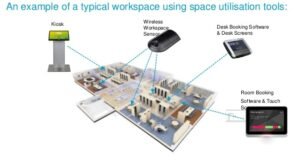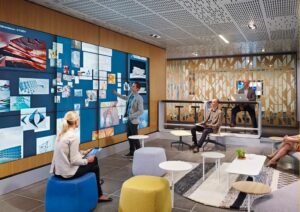Organizations that adopted or are willing to adopt a digital workplace offer an increased access to technology, allowing coworkers to collaborate constantly, enhancing their efficiency and leading to an enhanced customer satisfaction. In this article, we are going to look at this from a different angle.
The numerous benefits that are offered to businesses when adopting a digital workplace, like enhanced communication and collaboration, mobility, and ease the process of searching and finding information, are strongly influenced by the way you design your digital workplace environment.
Branding
When it comes to your digital workplace design, one of the main aspects that should be undertaken by your organization is branding.
Branding is a means for an organization to differentiate its services or products from the rest. A unique name, great PR and/or advertising or images are some of the tools an organization has in hand to do so.
Branding offers organizations the opportunity to shape the desired image or perception consumers will have in mind when thinking about their products
Customizing the look and feel of your intranet will boost your employee’s engagement, give them a sense of belonging but also will make sure that you use that opportunity in the case of an extranet implementation as well.
Develop Application Integration
According to a 2014 study conducted by Teknion, organizations increasingly offer workplace mobility programs to support going digital. In fact, they found out that it generates about 30% of savings for the selected organizations. One of the main challenges that organizations are facing when designing their digital workplace is a poor integration of these technologies with business software applications (like CRMs and ERPs).
Workflow Automation
Employers used to rely on workflow formulas to measure employee’s productivity (think charts, graphs, etc.). Today, organizations use workflow automation solutions to coordinate the activities between workers, measure production and help make work completion as efficient as possible i.e. digitizing workflow formulas into your computers.
Your production will gain in efficiency through collaboration tools and workflows for your team.
Have an Open Workspace
The digital workplace, even though mainly influenced by technology, is also about the work environment surrounding collaborators. Even though technology plays a significant role in designing your digital workplace, the importance of your organization’s’ physical workplace layout should also be considered. According to the previously cited Booze & Company study, organizations that are striving for an optimal digital workplace usually hold offices that are too cluttered which can limit employee creativity and morale.
Adopt a Human-Centric Approach
The productivity of workers is impacted by their tools effectiveness. Even though a poorly designed system automating can impact productivity, the issues they face can be solved with a better purpose of the solutions they use. However, when people use digital collaboration tools, organizations need to address a more complex dynamic between the people and the tools. To succeed in creating a productive environment and reducing friction, organizations should absolutely understand the context to address productivity.
A human-centric approach to designing and implementing your digital workplace will not only reduce the project failing, but it will also ensure your productivity outcomes.
In this increasingly digitalized world, embracing a digital workplace is becoming more common for businesses that are aiming to be up-to-speed. Taking into consideration not only the technology of your digital workplace but also its design should allow you to build a steady open workspace.
Designing Your Digital Workplace







Contact to Design My Space for Best Interior Decorator of home, commercial space, landscape etc.
office interior designer in noida
office interior designers in delhi
office interior designers in gurgaon
top office interior designers in gurgaon
residential interior designers
top interior designers in delhi
interior Designing Services In Gurgaon
interior Designing Services In Delhi NCR
Best Interior Designers Firm in Delhi
Best Interior Designers Firm in gurgaon
Best Interior Designers Firm in NCR
This comment has been removed by the author.
Excellent post and wonderful blog, this sort of interesting posts I really like, keep it up…
architecture
architecture firms in delhi
top architecture firms
top interior designers in delhi
This is Spacewood Interiors and offering you top class of interiors service in home, office and commercials interiors desgn and decoration.
apple office interior
electrical turnkey contractors in delhi ncr
interior contractor in noida
interior turnkey contractors
turnkey contractor
turnkey contractors
turnkey contractors in delhi
turnkey contractors in delhi ncr
turnkey interior
turnkey interior contractors
turnkey interior contractors in bangalore
turnkey interior contractors in delhi
turnkey interior contractors in delhi ncr
turnkey interior solutions
turnkey interiors
turnkey interiors in inida
turnkey interior contractors in india
top turnkey interior contractors in india
top turnkey projects companies in india
office furniture India
corporate office interior contractor
hospital furniture in India
Very useful blog
https://interiorstudiobd.com
Good Information, Keep sharing content like this.
Interior Design Agency in Dubai
Architectural Consultants in Dubai
Architecture Firms in Dubai
Top Architecture Firms in Dubai
Interior Design Services in Dubai
Architecture Design Services in Dubai
If you are looking for modern designed modular furniture for your office or home then sosoffice is the best choice. loose furniture | modular office furniture | modular office furniture in India
Great work! Thank you for sharing this. Check it out our top notch services and solution on IT infrastructure services in chennai . Experts in Annual Maintenance Contract (AMC) services in chennai, Cloud Management Services in chennai, Cloud Advisory and Optimization Services in chennai, Cloud Implementation and Migration Service in chennai, Managed IT Services and Solutions in chennai, Cloud Security Services, Enterprise Networking and WIFI Solutions in chennai, Cyber Security Company, Penetration Testing Company